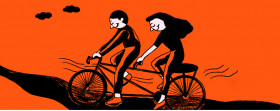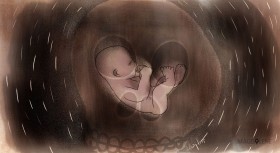I could barely hide my disappointment as the credit title rolled on. I guess I’d expected too much from the movie. It’s not that I found it bad, I just had have high hopes for the blockbuster movie about a topic that is supposed to hit home to me, and one that everyone was raving about.
Based on a biography of arguably one of the first transgender women to undergo Sex Reassignment Surgery (SRS), The Danish Girl tells of the journey of Lili Elbe’s journey—a Danish painter previously named Einar Wegener—to womanhood, following her gender realization which was triggered after posing as a female model for her then-wife’s painting.
Strangely, I’ve somehow failed to relate to most of Lili’s story. I suppose different time periods and social condition make her experience seem distant to mine. Unlike Lili, being part of the later transgender generation, I’ve benefitted more from modern technology to better understand myself
But at least, the astonishing performances from the actors and the cinematic visuals made me stay throughout the movie. Other movies with related themes, though, have fared worse.
Although transgender issue is set as the main plot in the Indonesia film Lovely Man, in many ways it fails to shed a good light on its transgender character. Being portrayed as a stereotypically flirtatious crossdressing man feels offensive to me as a transgender woman. And don't even get me started on the character Mariana (Barry Prima) in another flick Realita, Cinta, dan Rock' n Roll! Unsurprisingly, both characters are played by straight (at least publicly) cisgender man.
It frustrates me to see how transgender characters are often poorly portrayed through the lens of hetero-cis people. The irony is I've found some commercial movies to be more accurate when it comes to portraying transgender people’s life.
In 2000, 20th Century Fox released the first X-Men movie. Adapted from Marvel’s original superhero comic series, X-Men tells the story of individuals who were genetically born with X-gene, which grants them metahuman abilities. Unfortunately, their condition makes them vulnerable to society’s stigma and prejudice.
Now we’re talking!
Also read: Discriminated and Poor: The Plight of ‘Waria’ in Indonesia
Structural Hatred and Oppression
Dan Brown once wrote “we fear what we do not understand” in his book, The Lost Symbol (2009). This part of human nature may come off as a two-edged blade—we have it as a survival instinct to protect ourselves, yet it could potentially bring harm to others.
In X-Men, the general population view the mutants as a threat to humanity. They fear that the mutants’ capabilities may be a threat to their comfortable lives and even national security.
I remember being stunned as I watched a scene of a senate hearing in the first X-Men movie in which Dr. Jean Grey (Famke Janssen) was humiliated by the attendants of the hearing after she presented the mutant-human coexistence.
The scene reminds me of the time when Merlyn Sopjan—an Indonesian transgender human rights activist—was publicly shamed by dozens of political figures for talking about LGBTIQ rights during tvOne’s Indonesia Lawyers Club (ILC) in 2018.
In that particular X-Men scene, Senator Robert Kelly (Bruce Davidson) said “mutants are dangerous”, reflecting the existing prejudice against mutants for possibly abusing their abilities. The very same opinion was expressed by the other speakers during the ILC program.
“This [LGBTIQ] movement starts at a very low pace and will gradually become worse,” said legislator Supratman Andi Agtas, stressing the importance of repressing the LGBTIQ community as much as possible to prevent it from becoming a real threat to society.
It’s devastating to see how politicians both in the movie and real life view minority groups who just want to live peacefully as a plague to society, instead of real problems like corruption.
Also read: Would You Rather Accept Your Child or Bury Him?
Erasure of Minorities
Throughout my life, I’d often feel how the majority population is always at work to overshadow my identity. Transness is generally seen as something alien, leading to the idea that it has to be terminated.
In the movie X-Men: The Last Stand (2006), Warren Worthington II (Michael Murphy) as the head of Worthington Lab created a cure for the X-gene. This idea was driven by his shame of having a mutant child. In pushing mutants into extinction, Worthington’s innovation only made the opposing party become more militant.
This situation mirrors the transgender community’s fight against the attempts to erase our existence. One of the most evident examples is conversion therapy.
Conversion therapy works pretty much like the X-gene cure. Many conservatives believe it is effective in converting someone’s gender identity (or sexuality in general). The practices range from spiritual interventions to the so-called aversive therapy. Despite being proven to be harmful by the American Psychiatric Association (APA), multiple institutions across the world still preserve the practices.
Worthington’s story reminds me of the time when my own parents conspired with the management at my school to trick me into conversion therapy. I’d never experienced a worse betrayal than when I found out that my parents had spent a fortune to hire an unlicensed “psychotherapist” to get rid of what God had given me. It left me even more traumatized.
Also read: The Vicious Cycle of Transgender Women in Indonesia
Hiding One’s True Identity to Survive
The mutants are separated into two groups: the visible and the invisible ones. And just like the general rule of thumb, the physically visible mutants tend to have it harder to survive in society—much like “visible” transgender people in real life.
Some mutants like Nightcrawler and Angel aren’t left with many options but to embrace their unique appearance. Of course, a deep blue skin, elongated tail, and a pair of large, metallic wings can’t keep away those stares and fingers pointing at them at all times. On the other hand, mutants like Storm and Professor Xavier might have it easier to blend in with the crowds as their abilities tend to be invisible.
But of all the mutants, the one I admire most is Mystique. Despite being born with scaly blue skin, her gift enables her to disguise herself as a common-looking person. It is her struggle to always have to disguise herself in order to fit in with the humans that I—or many transgender people—can relate to on so many levels.
Just like her, sometimes I get tired of having to “disguise” myself as a cisgender woman just so a random dude doesn’t beat me up in public, or so a woman won’t scream at me when I’m taking a dump in the women’s restroom.
The struggle to frequently hide ourselves from people for survival is exhausting, and the X-men have accurately reflected that when even movies that were designed to speak about the issue couldn’t even come close.
Thankfully, filmmakers are getting more aware of the importance of delivering and portraying transgender people’s stories and characters more genuinely. I’m glad shows like Pose and Euphoria exist to raise the standard.
Of all the lines, there isn’t one that screams more about what I feel as a transgender woman than what Mystique (Jennifer Lawrence) delivered in X-Men: Apocalypse: “They still hate and fear us. It's just harder to see because they're more polite about it. I got sick of living that lie.”







Comments